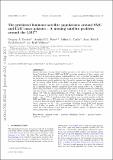| dc.contributor.author | Dooley, Gregory A. | |
| dc.contributor.author | Peter, Annika H.G. | |
| dc.contributor.author | Carlin, Jeffrey L. | |
| dc.contributor.author | Frebel, Anna | |
| dc.contributor.author | Bechtol, Keith | |
| dc.contributor.author | Willman, Beth | |
| dc.date.accessioned | 2020-04-27T20:27:16Z | |
| dc.date.available | 2020-04-27T20:27:16Z | |
| dc.date.issued | 2017-11 | |
| dc.date.submitted | 2017-07 | |
| dc.identifier.issn | 0035-8711 | |
| dc.identifier.issn | 1365-2966 | |
| dc.identifier.uri | https://hdl.handle.net/1721.1/124893 | |
| dc.description.abstract | Recent discovery of many dwarf satellite galaxies in the direction of the Small and Large Magellanic Clouds (SMC and LMC) provokes questions of their origins, and what they can reveal about galaxy evolution theory. Here, we predict the satellite stellar mass function of Magellanic Cloud-mass host galaxies using abundance matching and reionization models applied to the Caterpillar simulations. Specifically focusing on the volume within 50 kpc of the LMC, we predict a mean of 4-8 satellites with stellar mass M∗ > 10[superscript 4] M[subscript ⊙] , and 3-4 satellites with 80 < M∗ ≤ 3000 M[subscript ⊙] . Surprisingly, all 12 currently known satellite candidates have stellar masses of 80 < M∗ ≤ 3000 M[subscript ⊙]. Reconciling the dearth of large satellites and profusion of small satellites is challenging and may require a combination of a major modification of the M∗ −M[subscript halo] relationship (steep, but with an abrupt flattening at 10[superscript 3] M [subscript ⊙]), late reionization for the Local Group (z[subscript reion] ≲ 9 preferred), and/or strong tidal stripping. We can more robustly predict that ∼ 53% of satellites within this volume were accreted together with the LMC and SMC, and ∼ 47% were only ever Milky Way satellites. Observing satellites of isolated LMC-sized field galaxies is essential to placing the LMC in context, and to better constrain the M∗ − M[subscript halo] relationship. Modeling known LMC-sized galaxies within 8 Mpc, we predict 1-6 (2-12) satellites with M∗ > 10[superscript 5] M [subscript ⊙] (M∗ > 10[superscript 4] M[subscript ⊙]) within the virial volume of each, and 1-3 (1-7) within a single 1.5º diameter field of view, making their discovery likely. Key words: galaxies: dwarf — galaxies: Magellanic Clouds — galaxies: haloes —= methods: numerical | en_US |
| dc.description.sponsorship | National Science Foundation (U.S.) (CAREER Grant AST-1255160) | en_US |
| dc.publisher | Oxford University Press (OUP) | en_US |
| dc.relation.isversionof | http://dx.doi.org/10.1093/MNRAS/STX2001 | en_US |
| dc.rights | Creative Commons Attribution-Noncommercial-Share Alike | en_US |
| dc.rights.uri | http://creativecommons.org/licenses/by-nc-sa/4.0/ | en_US |
| dc.source | arXiv | en_US |
| dc.title | The predicted luminous satellite populations around SMC- and LMC-mass galaxies – a missing satellite problem around the LMC? | en_US |
| dc.type | Article | en_US |
| dc.identifier.citation | Dooley, Gregory A., et al. “The Predicted Luminous Satellite Populations around SMC- and LMC-Mass Galaxies – a Missing Satellite Problem around the LMC?” Monthly Notices of the Royal Astronomical Society 472, 1 (November 2017): 1060–73. | en_US |
| dc.contributor.department | Massachusetts Institute of Technology. Department of Physics | en_US |
| dc.contributor.department | MIT Kavli Institute for Astrophysics and Space Research | en_US |
| dc.relation.journal | Monthly Notices of the Royal Astronomical Society | en_US |
| dc.eprint.version | Author's final manuscript | en_US |
| dc.type.uri | http://purl.org/eprint/type/JournalArticle | en_US |
| eprint.status | http://purl.org/eprint/status/PeerReviewed | en_US |
| dc.date.updated | 2019-03-22T13:22:55Z | |
| dspace.embargo.terms | N | en_US |
| dspace.date.submission | 2019-04-04T10:59:05Z | |
| mit.journal.volume | 472 | en_US |
| mit.journal.issue | 1 | en_US |
| mit.license | OPEN_ACCESS_POLICY | en_US |
| mit.metadata.status | Complete | |
